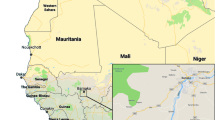Abstract
The attraction of the Nun Moth (L. monacha) and Gypsy Moth (L. dispar) to sticky traps (0.5×1.0 m) baited with racemic disparlure was tested in the forestry district of Freiburg-Stadt. A total of 81 traps were baited alternately with 0.01 mg (10−5), 1 mg (10−3) disparlure (diluted in pentane) and control (pentane only).
Male pupae ofL. monacha (10.102; 19.5–12.6) andL. dispar (5.532; 14.6–4.7.) were placed in the center of the test area before the flight period of the natural population. Of 6.834L. monacha and 4.990L. dispar moths that emerged, 365 (=5.3%) and 329 (=6.6%) respectively were recaptured on the traps. During the flight of the natural population, 274L. monacha (3.7–26.8.) and 818L. dispar (14.7–3.9.) were collected from the traps. With a few exceptions, the traps were examined daily. No significant difference was noticed in the behavior of the laboratory-reared insects and the natural population.
Zusammenfassung
Der Anflug der NonneLymantria monacha L. und des SchwammspinnersL. dispar L. an razemisches Disparlur wurde mittels Leimfallen (0,5×1,0 m) im Forstamt Freiburg-Stadt untersucht. Insgesamt wurden 81 Fallen in sternförmiger Anordnung abwechselnd mit 0 mg (UB), 0,01 mg (10−5) und 1 mg (10−3) Disparlus (Lösungsmittel: Pentan) geködert.
Vor dem Flugbeginn der Naturpopulation wurden ♂ ♂-Puppen vonL. monacha (10 102; 19. 5.–12. 6.) bzw.L. dispar (5532; 14. 6.–4. 7) im Zentrum der Fallen ausgebracht. VonL. monacha schlüpften 6834, vonL. dispar 4990 Falter; hiervon wurden 365 (=5,3%) bzw. 329 Freilassungsversuch wurde der Anflug der Naturpopulation vonL. monacha (3. 7.–26. 8.; 274 Falter) undL. dispar (14. 7.–3. 9; 818 Falter) an dier Fallen registriert. Bis auf wenige Ausnahmen wurde täglich kontrolliert. Bei beiden Arten war im Verhalten der Falter kein grundsätzlicher Unterschied zwischen Labor- und Naturpopulation festzustellen.
Von den gefangenen Nonnenfaltern flogen im Mittel 92% die Fallen mit der höheren Konzentration (10−3) an gegenüber nur 7% bei 10−5. Der Schwammspinner flog demgegenüber beide Konzentrationen des Disparlur annähernd gleich stark an (10−5: 54%, 10−3: 43%). Es wird angenommen, daß die gegenüber 10−5 größere Menge an (−)-Disparlur in der Konzentration 10−3 beim Schwammspinner das Rezeptor-System blockiert und so die Lockwirkung der aktiven (+)-Enantiomere herabsetzt. Bei der Nonne dagegen stieg die Lockwirkung des Disparlur mit der Konzentration an; der Anteil der (−)-Enantiomere hatte keinen hemmenden Einfluß.s
Similar content being viewed by others
Literaturverzeichnis
Beroza, M.;Knipling, E. F., 1972: Gypsy Moth control with the sex attractant pheromone. Science177, 19–27.
Bierl, B. A.;Beroza, M.;Adler, V. E.;Kasang, G.;Schröter, H.;Schneider, D., 1975: The presence of Disparlure, the sex pheromone of the Gypsy Moth, in the female Nun Moth. Z. Naturforsch.30 c, 672–675.
Boller, E., 1972: Behavioral aspects of mass-rearing of insects. Entomophaga17, 9–25.
Boness, M.;Schulze, W.;Skatulla, U. 1974: Versuche zur Bekämpfung der NonneLymantria monacha L. mit dem synthetischen Pheromon Disparlure. Anz. Schädlingskde.47, 119–122.
Cameron, E. A., 1973: Disparlure: A potential tool for Gypsy Moth population manipulation. Bull. ent. Soc. Am.19, 15–59.
Ferenczy, J.;Holzschuh, C. 1976: Der Sexuallockstoff Disparlure, ein Helfer gegen die Nonne (Lymantria monacha L.). Allg. Forstztg.87, 109–112.
Ferguson, D. C., 1976: The correct name for the gypsy moth. Coop. Plant Pest Rep.1, 83–84.
Huettel, M. D., 1976: Monitoring the quality of laboratory-reared insects: A biological and behavioral perspective. —Envir. Ent.5, 807–813.
Klimetzek, D.;Loskant, G.;Vité, J. P.;Mori, K., 1976: Disparlure: Differences in pheromone perception between Gypsy Moth and Nun Moth. Naturwiss.63, 581–582.
Plimmer, J. R.;Schwalbe, C. P.;Paszek, E. C.;Bierl, B. A.;Webb, R. E., Marumo, S.;Iwaki, S., 1977: Contrasting effectiveness of (+)- and (−)-enantiomers of disparlure for trapping native populations of Gypsy Moth in Massachusetts. Envir. Ent.6, 518–522.
Richerson, J. V., 1976: Relative attractiveness of irradiated laboratory-reared female Gypsy Moths and nonirradiated laboratory-reared and feral females. J. econ. Ent.69, 621–622.
Richerson, J. V.;Cameron, E. A., 1974: Differences in pheromone release and sexual behavior between laboratory-reared and wild Gypsy Moth adults. Envir. Ent.3, 475–481.
Roelofs, W. L.;Carde, R. T., 1977: Responses of Lepidoptera to synthetic sex pheromone chemicals and their analogues. Ann. Rev. Ent.22, 377–405.
Roelofs, W. L. et al., 1977: J. insect Physiol. (in lit.).
Schneider, D.;Lange, R.;Schwarz, F.;Beroza, M.;Bierl, B. A. 1974: Attraction of male Gypsy and Nun Moths to Disparlure and some of its chemical analogues. Occologia (Berl.)14, 19–36.
Schneider, D.;Kafka, W. A.;Beroza, M.;Bierl, B. A., 1977: Odor receptor responses of male Gypsy and Nun Moths (Lepidoptera, Lymantriidae) to Disparlure and its analogues. J. comp. Physiol.113, 1–15.
Schönherr, J., 1972: Die Wirkung von Disparlure auf die Nonne,Lymantria monacha L. Z. ang. Ent.71, 260–263.
Schröter, H.-J.;Lange, R., 1975: Untersuchungen über den Einfluß des weiblichen Sexualpheromons auf die Flugaktivität der Männchen vonLymantria monacha L. im Freiland. Z. ang. Ent.77, 337–341.
Skuhravy, V.;Hochmut, R., 1976: Methodische Probleme des Fanges vonLymantria monacha L. (Lep. Lymantriidae) in verschiedenen Pheromon-Lockfallen. Anz. Schäd-lingskde.49, 55–58.
Vité, J. P.;Klimetzek, D.;Loskant, G.;Hedden, R.;Mori, K., 1976: Chirality of insect pheromones: Response interruption by inactive antipodes. Naturwiss.63, 582–583.
Author information
Authors and Affiliations
Additional information
Mit 6 Abbildungen
Mit Unterstützung der Wissenschaftlichen Gesellschaft Freiburg und der Müller-Fahnenberg-Stiftung der Universität Freiburg.
Rights and permissions
About this article
Cite this article
Klimetzek, D., Schönherr, J. Unterschiede im Anflugverhalten von Lymantria monacha L. und L. dispar L. an razemisches Disparlur. Anz. Schadlingskde., Pflanzenschutz, Umweltschutz 51, 23–29 (1978). https://doi.org/10.1007/BF01903248
Issue Date:
DOI: https://doi.org/10.1007/BF01903248




